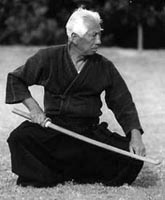 The ‘Kihon’ of Uchikomi and Kiriotoshi
The ‘Kihon’ of Uchikomi and Kiriotoshi
"In Shintō Musō-ryū Jō, Hikiotoshi is one of the secret techniques, and when I first came to understand it I felt that Kiriotoshi of Kenjutsu is also a secret technique" – Nishioka Tsuneo shihan
Commentary by Ishida Hiroaki shihan:
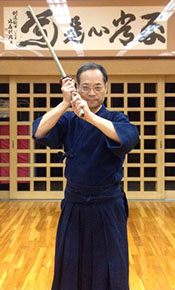
何事も「基本に勝る奥義なし」と言われるが、神道夢想流杖においても同じである。
It's said that in anything there's “no secret techniques better than Kihon”, and this is the same in Shintō Musō-ryū Jō.
西岡先生もこのことは常に仰って居られ、その中でも杖の打ち込みを特に大切にされて居た。
Nishioka sensei also always mentioned this, and amongst all Kihon, he especially placed importance on Uchikomi in Jō.
これは何度も言うように、決して構えた太刀を打つのではなく、切りかかって来る太刀に後の先(ごのせん)で合(ガッ)し勝つことの稽古である。これは、神道流剣術の基本であり奥義である。
As I have said many times, it is not to hit the tachi that was placed in front of you, but it is the training to win against the tachi cutting at you in motion using Go-no-sen. This is the foundation of Shintō-ryū Kenjutsu and a secret technique.
否、神道流を祖流とする新陰流、一刀流などにも共通する奥義であり、更には、神道流の淵源である天真正伝・天真兵法の奥義なのである。
No, not only in Shintō-ryū Kenjutsu but it is a secret technique that is common in Shinkage-ryū and Ittō-ryū, and others that have Shintō-ryū as the originating ryū. Furthermore, it is a secret technique in Tenshin Shōden ・ Tenshin Hyōhō that are the origin of Shintō ryū.
例として、引落打ちについて西岡師範の動きを述べます。
As an example, I will explain Nishioka-shihan's movements in Hikiotoshi-uchi.
先ず打ち込みだが、西岡先生も常に打ち込みの重要性を説いて居られた様に、この打ち込みは全ての技の基準となるものである。
First of all, Uchikomi. The importance of Uchikomi was always explained by Nishioka sensei and as this suggests, Uchikomi forms the basis of all waza.
本手打ち、逆手打ち、引落し打ちも、この打ち込みが出来なければ単なる打突のみの打ちとなる。
If done without this Uchikomi; Honte-uchi, Gyakute-uchi and Hikiotoshi-uchi all become a mere hit.
相手の気・剣・体を同時に崩す打ち、これが打ち込みであり、神道夢想流杖の打ちである。
The strike that breaks the opponent's Ki (spirit; mind), Ken (sword) and Tai (body) simultaneously, this is Uchikomi and the strike of Shintō Musō-ryū Jō.
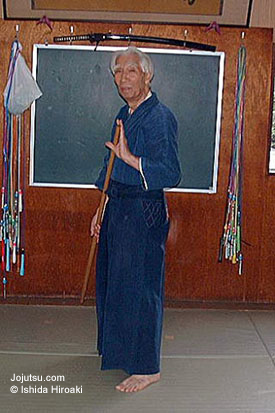 |
引落しの構えです。
Hikiotoshi-no-kamae |
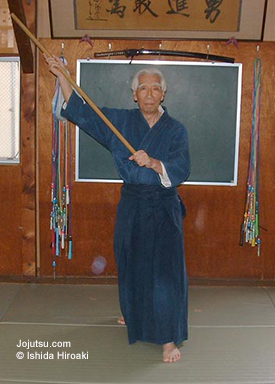 |
引落しの構えから杖を振り上げたところですが、体は正対し、左手は正中(大凡、乳の高さ)にあります。
This shows that upon raising the Jō from Hikiotoshi-no-kamae, the body is squared and the left hand is on the centre-line (almost at the height of the breast).
杖は左手を中心に大凡45度傾斜して居ます。これが大切なところで、ここで杖を立ててしまうと杖の陰に隠れて打ちを行なうことが出来ず、単なる打つのみの動作になってしまいます。
The Jō is raised, roughly at a 45 degree angle to the body, having the left hand in the centre; this is the most important point. If one holds the Jō upright here it will not be possible to shield with the Jō to strike, and the action becomes a mere hit.
ここからそのまま、45度に切下すように打ち下します。
From here, leave everything as it is and strike through, cutting down at 45 degrees. |
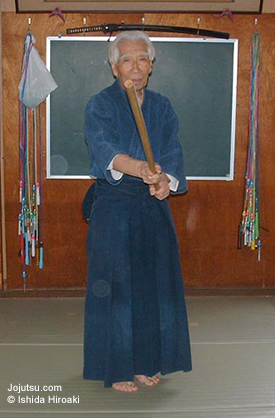 |
杖先は相手の鼻先を必ず通ることが大切です。
It is important to make sure that the tip of the Jō passes by the tip of the opponent's nose.
体は45度左向き半身になって、杖は相手に30度位の角度で打ち込んで居ます。この時、杖の陰にわが身が隠れつつ、杖先は晴眼(眉間)を攻めて居ます。
The body becomes 45 degrees leftward to Hanmi and the Jō strikes in to the opponent at about a 30 degree angle. At this point, the tip of the Jō is threatening the Seigan (between the eyebrows) while our own body is shielded behind the Jō.
これにより、自己を杖で守りつつ、相手の太刀を払い、相手の体を崩し、相手の気を挫くことが出来ます。これを三挫きと云いますが、この三つを同時に崩すところに杖の妙味があります。
It is then possible to sweep the opponent's sword, collapse the opponent's posture, and jolt and distort their intent, all the while protecting oneself with the Jō. This is called Sankujiki, a point when all three are broken simultaneously and where the exquisiteness of the Jō's lies.
これは新陰流の合し打ち、一刀流の一文字の打ちと同じ理合いです。この時、相手は完全に気・剣・体が崩されて居ます。
This same riai (underlying rationale) is found in Shinkage-ryū's Gasshi-uchi and in Ittō-ryū's Ichimonji-no-uchi*. At this point the opponent's Ki (spirit; mind), Ken (sword) and Tai (body) have been completely broken.
* Kiriotoshi
|
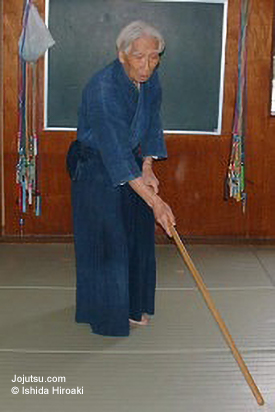 |
上の動作に続いてそのまま切下します。
Without changing anything cut down in a continuation of the above movement. |
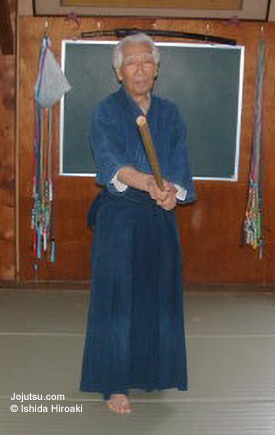 |
その後、右足を出しながら、打った杖の動線をそのまま元に戻って右本手に構えます。
Afterwards, step out with the right foot, return the Jō back along the line it has just travelled in order to assume Migi-honte-ni-kamae. |
技術的にも、あらゆる技は胸郭と肩・肘の開閉に依り行なうことが秘訣で、西岡先生はこれを見事に実践されて居た。本手打、逆手打、引落打、繰り付け、繰り放しなど、良く見れば全てこの開閉に依り行なって居られた。
Technically, the secret is that all techniques are performed by opening and closing the chest and shoulders / elbows, and Nishioka sensei put this into practice superbly. Honte-uchi, Gyakute-uchi, Hikiotoshi-uchi, Kuritsuke, Kurihanashi, etc. are all based on this opening and closing, if you look at them carefully.
神道夢想流杖は表一本目の太刀落に始まり、奥の最後のアウンで終わる。「アウン」とは、「阿吽」と書き、開閉のことである。
Shintō Musō-ryū Jō starts with Tachiotoshi*, the first kata in Omote, and ends with Aun, the last in Oku. "Aun" is written in Kanji as "阿吽" and means opening and closing.
古流の形の名は、やはりその名を通して何かを教えて居る筈である。
After all, the names of the kata in Koryū ought to teach us something through their names.
* For those that maybe interested, there's also a related and pertinent translation of Ishida sensei's thoughts on Tachiotoshi within the main timeline on our Facebook page.
Note: In SMR Jō, Uchikomi can refer to the Kihon set of hasuji practice drills, however, Ishida sensei's abovementioned use is emphasising the principle of Uchikomi within waza. Also, Uchikomi is a wide-ranging term used across various Japanese martial art disciplines, and in Japanese is represented by either 打込 (打ち込み) or 内込. The former is typcially used in Weapons-based disciplines and the latter in Yawara/Taijutsu, like Jūdō. They're different words with separate meanings.
Text and Images ©2006-2017 Ishida Hiroaki & Kobudōkai Australia.
No part of this material may be reproduced in any form or by any means, electronic or mechanical, including photocopy, without permission in writing from Kobudōkai Australia. However, you are welcome to share a link to this article on such social media as Facebook, Instagram or Twitter.
If the embedded "Uchikomi with Ishida sensei" video isn't displaying below, please consider
temporarily disabling your browser's tracking protection or visit our Facebook page.
Many more videos can be found on our Facebook page. Additionally, there are several
other English translations of Ishida Sensei's 2013 Keiko Journals, some with
commentary, on the main timeline of our Facebook page.
